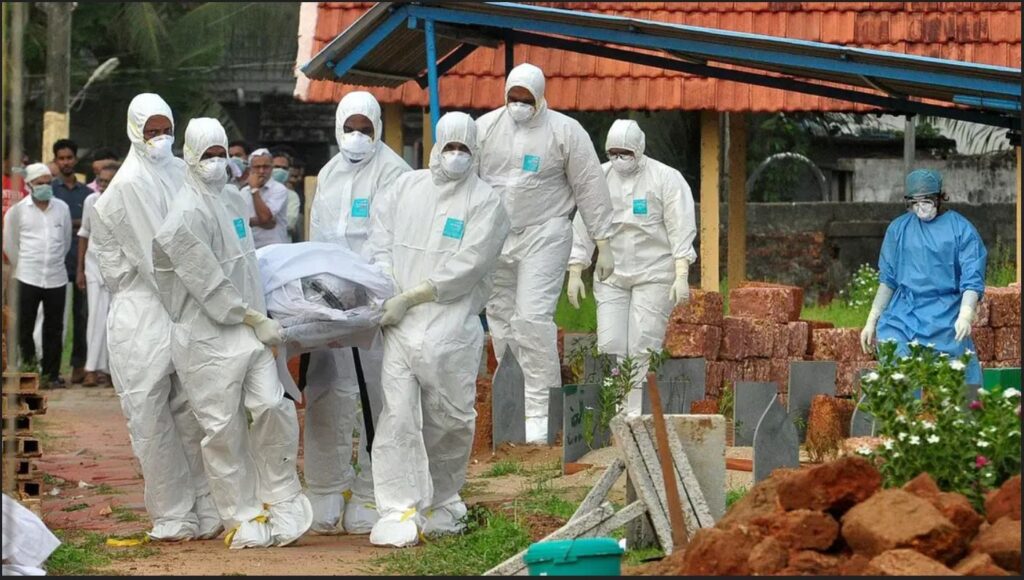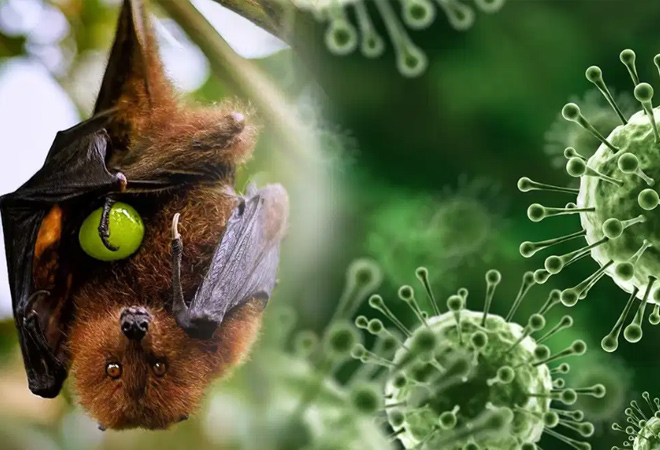
source: alarabiya.net
In the realm of infectious diseases, the Nipah virus stands out as a highly contagious and deadly pathogen, capable of causing severe encephalitis (inflammation of the brain) and respiratory illness. The virus has been a source of concern in various parts of the world, with Kerala, India, experiencing a notable outbreak in May 2022. This expansive article delves into the multifaceted aspects of the Nipah virus Kerala, tracing its origins, detailing its symptoms, elucidating preventive measures, and exploring the groundbreaking research being conducted in Kerala to combat this formidable adversary.
Origins of the Nipah Virus
The Nipah virus made its ominous debut on the scientific stage in 1998 when it was first identified in Malaysia. Since then, it has left a trail of outbreaks in its wake, affecting countries such as Bangladesh, India, and the Philippines. Of particular significance is the most recent outbreak in Kerala, India, which was reported in May 2022, marking the virus’s initial appearance on Indian soil.
Symptoms of Nipah Virus Infection
The insidious nature of Nipah virus infection becomes apparent when one considers the array of symptoms it presents, typically manifesting within 4 to 14 days after exposure. These symptoms encompass a spectrum of ailments, including:
- Fever: Nipah virus infection often starts with an unrelenting high fever.
- Headache: Severe headaches plague those afflicted by the virus.
- Muscle Pain: Aches and discomfort in the muscles are commonplace.
- Vomiting: Nausea and vomiting can be frequent.
- Dizziness and Drowsiness: Victims may experience dizziness and excessive drowsiness.
- Altered Consciousness: The virus can trigger alterations in consciousness.
- Encephalitis: In severe cases, Nipah virus can incite the inflammation of the brain (encephalitis).
- Respiratory Illness: The virus can precipitate severe respiratory illness, further complicating the prognosis.

source: orfline.org
Treatment for Nipah Virus Infection
Regrettably, a specific antiviral treatment for Nipah virus infection remains elusive. Medical intervention primarily focuses on supportive care, which encompasses measures to alleviate symptoms and avert complications. Such measures may include:
- Intravenous fluids to sustain hydration and balance electrolytes.
- Oxygen therapy to bolster breathing.
- Administration of anticonvulsants to mitigate seizures.
- Use of medications to curtail inflammation.
- Prescribing pain relievers to alleviate discomfort.
Prevention of Nipah Virus Infection
Preventing Nipah virus infection assumes paramount importance due to its alarmingly high mortality rate. Employing effective preventive measures is critical. Here are some strategies to guard against infection:
- Avoid Contact with Bats: Bats are the natural reservoir of the Nipah virus. Therefore, it is imperative to steer clear of bats and eschew contact with their secretions and excretions.
- Adopt Safe Food Practices: Reducing the risk of infection entails refraining from consuming raw fruits that may have been contaminated by bat saliva. Additionally, thoroughly washing fruits and vegetables before consumption and ensuring meat and eggs are cooked thoroughly can contribute significantly to prevention.
- Exercise Caution Around Sick Individuals: Vigilance is required when interacting with individuals displaying symptoms of illness, and maintaining distance from animals exhibiting unusual behavior is advisable.

Nipah Virus Outbreak in Kerala
The Nipah virus outbreak that unfolded in Kerala in 2022 marked a watershed moment as the virus made its first appearance in India. The outbreak was concentrated in Kerala’s Kozhikode district, where it resulted in 21 cases and 17 fatalities.
The catalyst for the outbreak is believed to have been an individual’s contact with a fruit bat, with subsequent transmission to family members and other community members. Kerala’s response to the outbreak was swift and encompassed various measures:
- Establishment of isolation wards in hospitals for the treatment of infected patients.
- Rigorous contact tracing of individuals exposed to the virus to identify and monitor those at risk.
- Public awareness campaigns educating the populace about the Nipah virus and the methods of prevention.
The concerted efforts yielded success, and the outbreak was effectively contained, with the last reported case surfacing in June 2022.
Read More: A Simple Guide to Removing Acne or Pimples at Home
Other Nipah Virus Outbreaks
Apart from the Kerala outbreak, several other Nipah virus outbreaks have been documented in recent years. These include outbreaks in Malaysia (1998), Bangladesh (multiple outbreaks spanning 2001 to 2021), India (occasional outbreaks since 2001), the Philippines (2004), and Cambodia (2012).
Transmission of Nipah Virus
Understanding the modes of transmission is pivotal in the battle against the Nipah virus. The virus is primarily transmitted from bats to humans and subsequently from humans to humans through direct contact with infected secretions or excretions. Transmission occurs via various routes, including:
- Contact with the saliva or urine of infected bats.
- Direct contact with the blood or body fluids of infected individuals.
- Consumption of raw fruits contaminated by bat saliva.
Risk Factors for Nipah Virus Infection
Certain individuals are at elevated risk of Nipah virus infection, including:
- Individuals with close contact with bats, such as fruit bat hunters.
- Residents of areas with a history of Nipah virus outbreaks.
- Healthcare workers who are exposed to infected patients.
Diagnosis of Nipah Virus Infection
Prompt diagnosis is pivotal in containing the spread of the virus. Diagnosis entails a meticulous physical examination and inquiries about symptoms and travel history. Blood tests are frequently employed to confirm the diagnosis definitively.
Complications of Nipah Virus Infection
Nipah virus infection is fraught with the potential for severe complications. These encompass encephalitis, respiratory illness, coma, and, regrettably, death. The high mortality rate associated with the virus underscores the urgency of early detection and intervention.
Vaccination and Research
Currently, an approved vaccine for Nipah virus prevention remains elusive. Nonetheless, researchers are vigorously developing potential vaccines, with a recombinant DNA vaccine displaying promise in animal studies. Anticipated clinical trials of this vaccine in humans are slated to commence in 2023.
Ongoing Research in Kerala
Kerala has emerged as a bastion of Nipah virus research since the outbreak in 2018. Significant findings and ongoing research endeavors include:
- Endemic Nature: Nipah virus is endemic in Kerala, signifying its persistent presence within the population.
- Natural Reservoir: Fruit bats are identified as the natural reservoir of the Nipah virus in Kerala.
- Transmission Insights: The virus is transmitted through contact with bat saliva or urine and through the consumption of fruits contaminated with bat saliva.
- Human-to-Human Transmission: Notably, the virus can be transmitted from human to human through contact with infected blood or body fluids.
- High Mortality Rate: Nipah virus infection retains its high mortality rate, reaching up to 70%.
Research in Kerala is also delving into the development of vaccines and treatments for Nipah virus infection. One promising avenue is a DNA vaccine currently in the preclinical stage. Results from animal studies are encouraging, instilling hope for future human trials.
Conclusion
The Nipah virus looms as a formidable public health concern, necessitating comprehensive understanding and proactive prevention. Vigilance against contact with bats, adherence to safe food practices, and prompt medical attention in case of suspected exposure are pivotal strategies in combatting this lethal pathogen.
Kerala, India, has become a beacon of Nipah virus research, unraveling critical insights about the virus’s endemic nature and transmission dynamics. As research progresses, the development of vaccines and treatments beckons on the horizon, offering optimism for a future where the Nipah virus is less menacing.
Additional Information
For further context, here is additional information about the Nipah virus:
- The Nipah virus belongs to the Henipavirus family, which also includes the Hendra virus.
- It is a zoonotic virus, meaning it can be transmitted from animals to humans.
- Fruit bats serve as the natural reservoir of the Nipah virus.
- Airborne and casual contact transmission of the Nipah virus is not documented.
- The virus is infamous for its high fatality rate, which can reach up to 70%.
What to Do if Exposed to the Nipah Virus
In the event of potential exposure to the Nipah virus, swift action is imperative. Seeking immediate medical attention is vital. While specific treatments are lacking, supportive care can manage symptoms and forestall complications. Supportive care may encompass:
- Intravenous fluids to sustain hydration and balance electrolytes.
- Oxygen therapy to bolster breathing.
- Administration of anticonvulsants to mitigate seizures.
- Use of medications to curtail inflammation.
- Prescribing pain relievers to alleviate discomfort.
Government Initiatives to Prevent and Control Nipah Virus Infection
Governments play a pivotal role in the prevention and control of Nipah virus infection. Measures typically include:
- Public education campaigns to enhance awareness about the Nipah virus and preventive measures.
- Robust surveillance systems for detecting cases of Nipah virus infection.
- Rigorous contact tracing to identify and monitor individuals exposed to the virus.
- Isolation of infected patients to limit transmission.
- Vaccination campaigns targeting individuals at high risk of Nipah virus infection.
What You Can Do to Prevent Nipah Virus Infection
Individuals also bear a significant responsibility in preventing Nipah virus infection. Here are proactive steps you can take:
- Avoid contact with bats and their secretions and excretions.
- Thoroughly wash fruits and vegetables before consumption.
- Ensure meat and eggs are cooked thoroughly.
- Exercise caution and maintain distance from sick individuals and animals.
- In cases of suspected exposure to the Nipah virus, seek immediate medical attention.
Research on Nipah Virus in Kerala
The burgeoning body of research on the Nipah virus in Kerala is illuminating critical aspects of the virus. Some key findings and ongoing research areas include:
- Endemic Nature: In Kerala, the Nipah virus is endemic, persistently present in the population.
- Natural Reservoir: Fruit bats are the natural reservoir of the Nipah virus in Kerala.
- Transmission Insights: The virus is transmitted through contact with bat saliva or urine and by consuming fruits contaminated with bat saliva.
- Human-to-Human Transmission: The Nipah virus can also be transmitted from human to human through contact with infected blood or body fluids.
- High Mortality Rate: Nipah virus infection can have a high mortality rate, reaching up to 70%.
Researchers in Kerala are actively working to develop vaccines and treatments for Nipah virus infection, including a promising DNA vaccine that is progressing through preclinical stages.
Conclusion
The Nipah virus presents a serious public health threat, but knowledge and preventive measures can significantly reduce the risk of infection. By avoiding contact with bats and following safe food practices, individuals can protect themselves and their communities from this deadly virus.
If there is a suspicion of Nipah virus exposure, seeking immediate medical attention is essential. While specific treatments are lacking, supportive care can help manage symptoms and prevent complications.
In Kerala, ongoing research efforts are shedding light on the virus’s characteristics and paving the way for potential vaccines and treatments, offering hope for the future.









Pingback: Breaking News: Indian Visa Services in Canada is Suspended - Ansari Sahab
Pingback: A Simple Guide to Removing Acne or Pimples at Home - Ansari Sahab